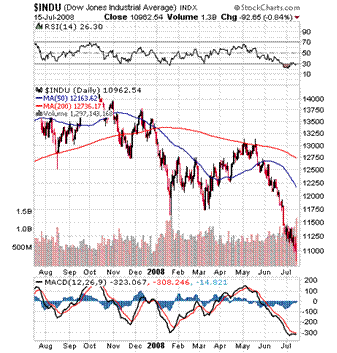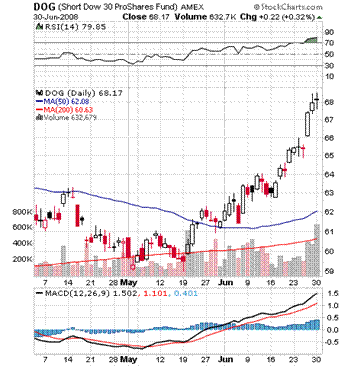How to Beat the Bear Market
Finally it’s definite. We’re in an official bear market with the Dow Jones Industrial Average down more than -% from its October high.

And there’s no end in sight as Fannie
(
FNM |
Quote |
Chart |
News |
PowerRating) and Freddie
(
FRE |
Quote |
Chart |
News |
PowerRating) struggle for survival and Depression Era-like Fed. Intervention seems to be occurring on an almost daily basis. Adding to the gloom are the specters of soaring gas and oil prices, the meteoric commodity sector and the seemingly endless implosion of the housing market.
All in all, a long, hot summer and definitely not a summer of love.
In my work at Wall Street Sector Selector, I monitor more than 100 ETFs in 11 sectors and there isn’t a lot of good news to be seen anywhere. Our signals all scream “SELL” and year to date, the only money to be made has been in inverse ETFs, those that move opposite to their underlying indexes, commodities, gold, and of course, black gold.
And if history is any guide, the near future might not be any rosier because the “bear” facts look like this:
- During the 20th Century, there have been 25 bull markets and 25 bear markets. The average bull market tends to last about 35 months and deliver a 115% gain in stock prices while the average bear market lasts about 18 months and results in roughly a 35% decline in market value.
- Bull markets historically double the value of your portfolio in just less than three years while bears will drop your asset value by 1/3 in 18 months.
- A bull market exists about 70% of the time while bear markets exist about 30% of the time.
- Recovery from bear markets can be long and painful. Investors in the S&P 500 Index have still not recovered from the 2000-2002 bear. The 1929 bear took 25 years to get over and between 1966 and 1982, investors endured 16 flat to negative years.
So the garden variety bear market means you’ll lose 1/3 of your net worth and need multiple years or even decades to get back to break even. Not a good scenario, especially for the 76 million baby boomers hurtling towards retirement and relying on ever shrinking 401ks to see them through their golden years.
And even if this is the garden variety bear market, we still have another 10-15% decline ahead of us before we reach an average bottom. In other words, a lot of pain and wealth destruction still lies ahead.
But it doesn’t have to be this way.
There is a group of well-informed individual and professional investors (myself and Wall Street Sector humbly included) who have been making gains since the market has turned south.
Here’s how they’re doing it:
- By moving a portion of their portfolios to cash. Professional investors and managers routinely move assets to cash when the market heads south. The old adage, “Cash is King,” is particularly valid during bear market melt downs.
- By using stop loss points to exit profitable positions and take profits home or minimize losses on losers.
- By buying protective put options to hedge long positions and limit losses without selling positions.
The point is that investors who are winning during this difficult time understand that if they’re not losing money, they’re effectively making money because when things turn back up, they’ll be moving ahead with wealth accumulation instead of spending what could be years just getting back to break even.
Investors Can Actually Make Money during Bear Markets
Most investors will continue doing what they always do, sitting around wringing their hands and worrying and watching Jim Cramer and looking for a nugget of hope from the Motley Fool.
But every problem brings an opportunity, and as the markets head south, one can still find potential profits by deploying two simple strategies:
- Buying stocks, ETFs or mutual funds that do well in bear markets. This is an obvious possibility, and, in fact, many investors have already figured this out. Gold has long been a safe haven in troubled times, and this time has been no different as it has been a stellar performer and is easily accessible through gold stocks or ETFs. Commodities have been on a tear and again are available through ETFs. Declining dollar funds and bond funds have also recently served investors well.
- Buying “inverse” ETFs that move opposite to the underlying index and so the value of the investment rises as the underlying index declines. This has been made possible through the relatively recent development of these inverse funds, and gives the investor the opportunity to “short” the market with investments that can be used in both qualified and unqualified accounts.
Here’s a recent chart of
(
DOG |
Quote |
Chart |
News |
PowerRating), the inverse Dow Jones Industrial ETF which vividly displays the potential profits on the other side of this troubling market.

So, the bear is here and he’s biting investors around the world. No one can say for sure how long he’ll be around or how deep the wounds will be. Sadly, there are no crystal balls, as much as we’d all like to have one.
But even these days, some investors are making money and all investors have alternatives to watching helplessly as a bear mauls their portfolios.
John Nyaradi is Publisher of Wall Street Sector Selector, an online newsletter specializing in sector rotation trading using Exchange Traded Funds.
